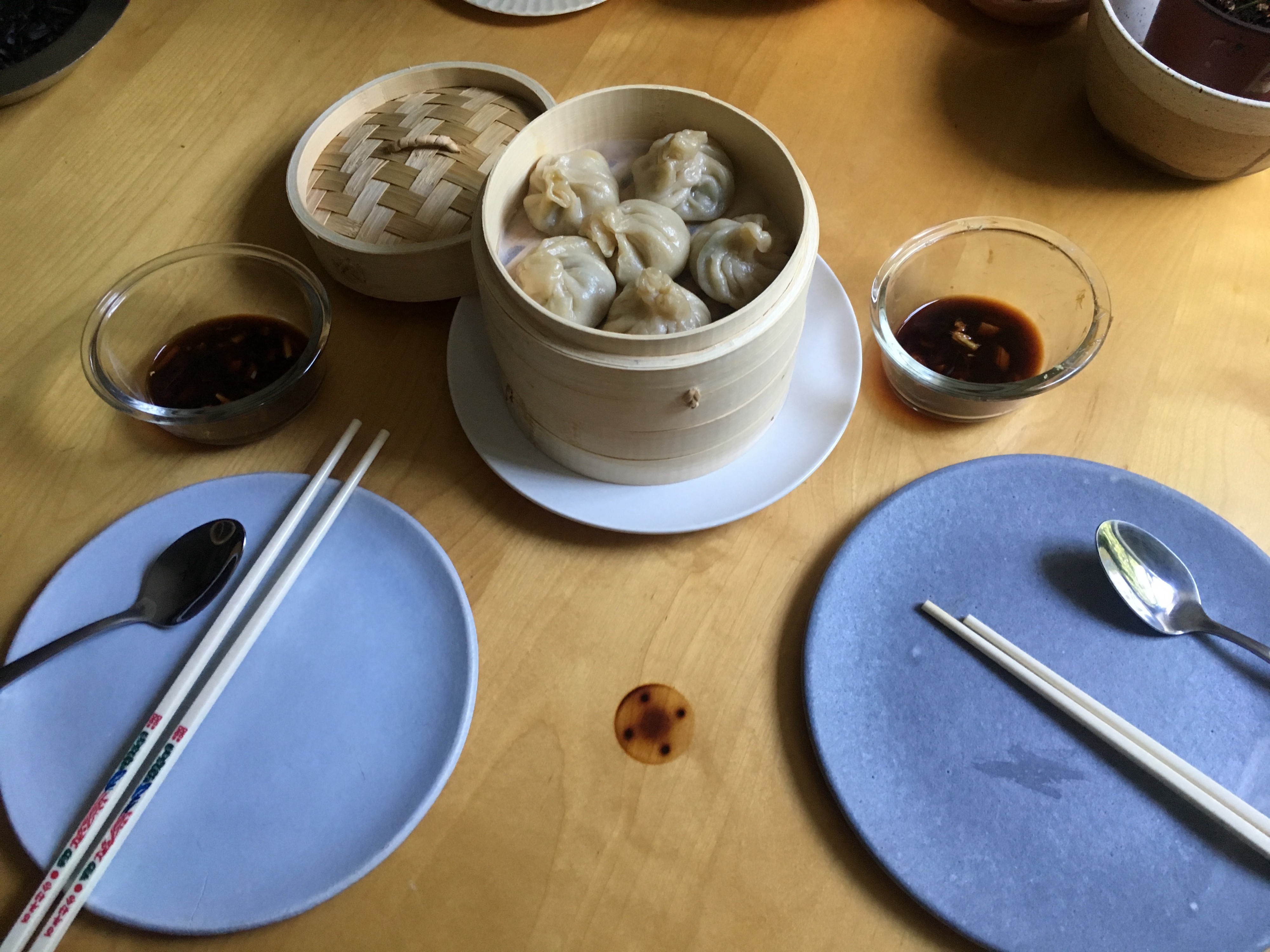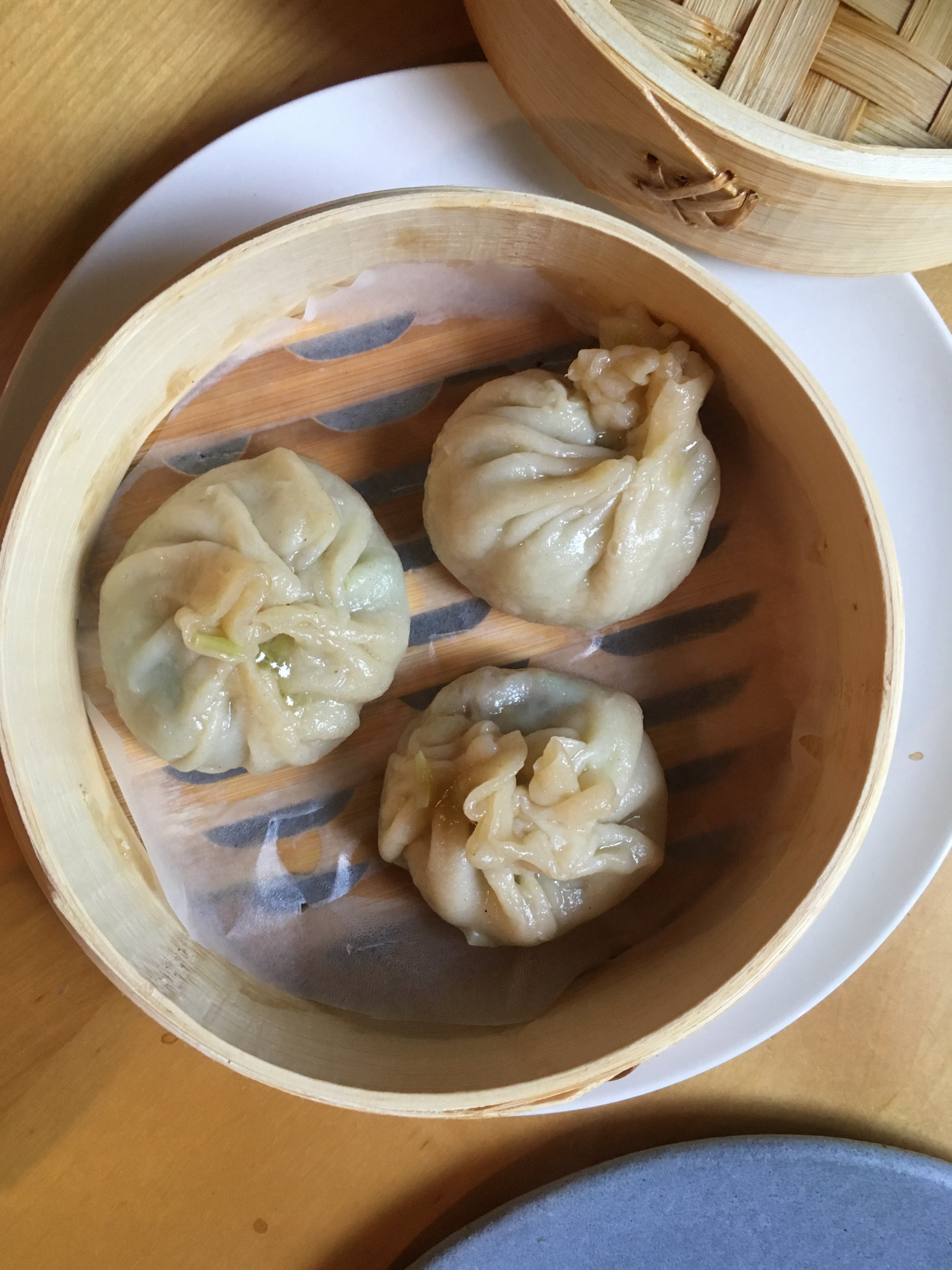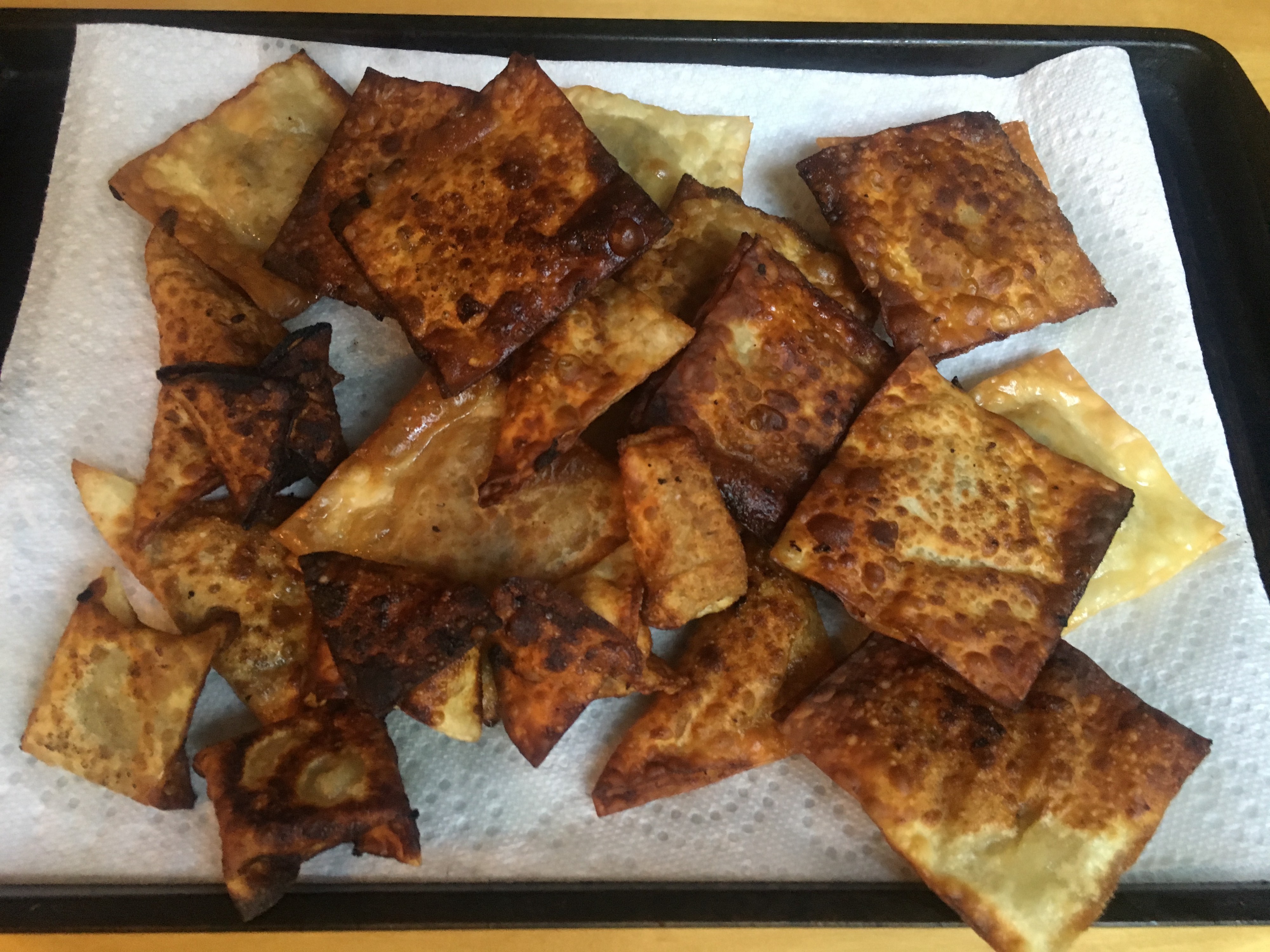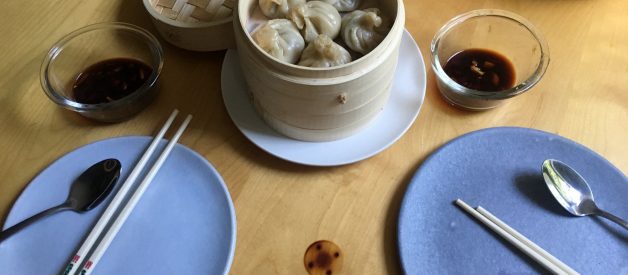Vegan soup dumplings are like the holy grail, or the fountain of youth: Elusive, perhaps unattainable. They certainly aren?t common.
 Photos: Jessica McKenzie
Photos: Jessica McKenzie
I dreamed about meatless soup dumplings for years. I even fantasized about opening a food truck dedicated to the delicacy. I?d perfect a version of the classic xiaolongbao, of course, but I also imagined little sacs of salty miso soup, filled with scallion, tofu, and seaweed, and pockets of sweet, luxurious onion soup. Last winter I finally purchased a little bamboo steamer at a kitchen supply store in Chinatown. I brought it home and installed it in the cabinet next to the bowls, where it sat untouched for months, a monument to my dormant culinary ambitions.
This summer I decided to actually follow through: First, to finally recreate the gush of salty, fatty broth when you bite into a soup dumpling, and the exquisite burst of black vinegar and ginger on the palate; and second, to test my reckless and thoroughly unfounded theory that agar agar, like a magic incantation, will transform most any soup into a dumpling filling.
The soupiness of the final product is the integral feature. A good vegan dumpling simply isn?t hard to find if you live in a major metropolis like New York City. Even if you don?t, you can probably find some half-decent ones in the freezer aisle at the grocery store. In short, there is little need to labor over tiny rounds of dough or finely dice vegetables for the filling, unless it?s for the sheer pleasure of creation.
Vegan soup dumplings, on the other hand, are like the holy grail, or the fountain of youth: Elusive, perhaps unattainable. They certainly are not common. Xiaolongbao, the soup-filled steamed buns said to have originated in Nanxiang, China, are usually filled with a mixture of pork, sometimes also crab.
My quest began, as many culinary adventures do these days, with an internet search. Turns out, vegan or vegetarian soup dumpling recipes are few and far between. The notable exception was a recipe by Christina Ng, a food writer and vlogger whose YouTube channel East Meets Kitchen features vegan versions of classic Asian dishes. Since her recipe attempts to mimic the original xiaolongbao as closely as possible, it seemed the best place to start.
In traditional, meat-filled soup dumplings, the soupiness comes from aspic, the jelly that forms when gelatinous meat stock cools. As the dumpling steams, the aspic remelts into a rich broth, and the dumplings sag sumptuously. In vegan dumplings, for the most part, that trick is achieved by adding agar, a gelatin-like thickener derived from red algae, to your soup base.
Ng?s recipe calls for steeping ginger and scallion in vegetable broth, dissolving the agar in the hot liquid, straining, and letting it set in the fridge until solid. She combines vital wheat gluten, water, oil, and seasoning to make a taffy-like mixture that approximates a pork meatball. Then comes the hard part.
The famous Taiwanese xiaolongbao at Din Tai Fung each have 18 precise, even folds. My dumplings decidedly did not. I was lucky to get 10 or more.
But in spite of my clumsiness with the dough, which resulted in irregularly-shaped, top-heavy nuggets, the dumplings that came out of the steamer were delicious, fragrant with scallion and ginger. When dipped (or drenched, according to preference) in Zhenjiang, or Chinkiang vinegar, a rice-based black vinegar, the resemblance to pork soup dumplings was uncanny. The taste-memory transported me back to the first time I tried soup dumplings, on a trip to Queens ? a lowly, unpaid intern not yet out of college ? dining with my supervisor after a site visit. The lunch was uncomfortable, but the dumplings were transcendent.
The only thing missing now was the soup.
I exaggerate, somewhat. The dumplings were soft and oozy, far wetter and squishier than any normal vegetable dumpling. But there was no pop, no gush, no burst. You couldn?t nibble a hole and slurp out the broth.

One possible culprit: the magical agar. Agar has a much higher melting temperature than meat-derived gelatin. It begins to solidify at room temperature. So it?s quite possible that every second we waited for the dumplings to cool so that we didn?t scald our tongues, the precious broth was becoming less and less brothy.
I began to play around, using Ng?s recipe as a loose framework, but borrowing doughs and other snippets from various xiaolongbao recipes on the net. I tried to do without ingredients I hate procuring and using in the kitchen. (Pre-made, boxed vegetable stock, for one, which is definitely a scam.)
I even attempted to bring the miso soup dumpling of my dreams to life, and produced a dozen or so bland, mushy goo-balls. I used too much agar, and the alarmingly firm-from-the-fridge miso cubes never fully melted in their steam bath. The ?soup? oozed from the dumpling like a jelly donut, but even thicker and more viscous.
It?s a delicate balance: If you use too much agar, the soup filling is too firm and won?t melt in the dumpling. If you use too little it melts as you work; if you?re using vital wheat gluten, your faux-meatball is likely to absorb any excess liquid, and poof! There goes the soup in your soup dumplings.
Ng solves this by using the bare minimum (it seems) of agar, but returning the dumpling filling to the freezer in between steps, so the agar stays cold and solid. But this can be trying and it drags out the dumpling-making process.
On top of everything, I was ? foolishly, insanely! ? attempting this project in the middle of July, as heat waves came and went and came again. The dumpling fillings, no matter how cold to start, melted to the touch as I tried to wrangle all of the bits inside the wrapper: some of the stretchy gluten-meat, some of the frozen shards of jelly, and, as I began experimenting with different fillings, bits of sauted vegetables.
Ground meat holds together nicely. It?s pliable, sticky even. Vegan dumpling filling is not. It wants to fall apart. Perhaps worst of all, it?s wet. If I tried to overfill the dumplings, or even just adequately fill them, liquid would spill out. The dumpling dough would become slippery and impossible to close, refusing to cohere at the edges, no matter how many neat folds I produced. ?Is this what it?s like to do brain surgery,? I wondered deliriously, sweat prickling my brow.
It was time to try something different.
Chris Santos, the chef and Chopped judge, is the creator of the original remix, the French onion soup dumpling, which he served at The Stanton Social from its opening in 2005 to its closing at the end of 2018. The dumplings were so popular that Santos also serves them at his new restaurant, Vandal. He has said these dumplings will probably be with him the rest of his life.
His recipe is available online, and I set about veganizing it.
I thinly sliced two medium onions and threw them into a hot pan with several generous glugs of olive oil and a pinch of salt and freshly ground pepper. I added two cloves of garlic, finely minced. I turned down the heat and waited for the onions to sweat, and then to soften and melt. After they were lightly caramelized, I poured in a cup of white vermouth and several sprigs of fresh thyme and rosemary from my herb pots. I let the wine and onions reduce down to a thick jammy texture, and then added a cup of mushroom broth. I had some frozen from the last time I rehydrated porcini mushrooms, and it was the exact rich, earthy flavor this soup wants.
This is easy, I thought to myself. So far, the only trick is to make the most delicious onion soup you can. Simple! When the soup was the thickness of a loose jam ? more onion than broth, but still some broth ? I poured it into a baking dish and popped it into the freezer.
What?s that you say? I forgot the agar? Something interesting and different about Santos? recipe is that it doesn?t call for a thickener. Instead, he freezes the soup mixture, then slices and dices it into cubes that are folded into wonton wrappers. (Finding vegan wonton wrappers ? or making your own ? might be the hardest thing about this recipe.) Santos brings the corners of the wrapper up to create a little purse-like shape. This is easier when the wrappers and filling have softened a bit, but not too much. I experimented with other shapes: a triangle, two wrappers joined together to make an extra-large ravioli shape. Then I slid the shapes into a pan of hot oil, enough to cover the bottom but not to submerge the dumplings. They need to be turned to brown on all sides.

This process is a race against time. I had turned out the sheet of frozen soup onto a cutting board, and as I formed the first few dumplings, the others were already beginning to return to their original, soupy state. On the other hand, frying is a lot faster than steaming, so dinner was ready relatively quickly. When all sides of the dumplings had browned, I fished them out of the oil and placed them on a sheet pan lined with paper towels.
The Santos French onion soup dumpling is served with a crouton, but that sounded extra dry to me, so I omitted it. Instead, I poured a small bowl of balsamic vinegar for dipping. Had I been more interested in presentation, I would have made a balsamic reduction to drizzle over the dumplings, and scattered finely minced fresh chives over the top.
Reader, two people ate all 24 in one sitting, even though the original recipe says it makes 36 and recommends preparing just 12 to serve and freezing the rest. Whoops! Just half of the dumplings, paired with a simple side salad, would have made a lovely, complete, and less gut-bursting meal for two, but I have no regrets.
Of course, these dumplings also lacked the gushiness I set out to demand from my soup dumplings, and yet the unexpected delight of rich onion soup encased in a crispy outer shell made up for it. I was satisfied, refreshed, and ready to try my hand at vegan xiaolongbao again.
Through trial and error, I came to a few conclusions while on my vegan soup dumpling journey.
The broth should be more concentrated than a regular soup broth. Not necessarily saltier, but with more intense flavors.
Agar won?t set if the liquid is too alcoholic (I found this out because the miso I bought is preserved with alcohol, and the mixture wouldn?t firm until I brought it to a boil and cooked out the alcohol).
Celeste Ng?s recipe completely converted me to the chewy, meaty texture of vital wheat gluten. But as with so many meat-substitutes, I want the substitute and then some more. I think vegan soup dumplings are improved by the addition of finely diced, cooked vegetables. The recipe below calls for cabbage and shiitake mushrooms, but finely chopped carrots or bok choy would add both flavor and color to the filling. Or, you could mix in minced chives for a soupy play on vegan pork and chive dumplings.
The black vinegar to serve is not optional ? it?s what makes this dish for me. The internet says you can substitute balsamic but honestly, I wouldn?t risk it.
I struggled to slice fresh ginger into fine enough strips to serve, and had better luck grating it directly into the vinegar.
A final serving tip: It?s easy to find the spoons that restaurants usually give customers who order soup dumplings! I walked into a restaurant supply store in New York City and bought five for $3 (a figure the woman made up on the spot because they usually sell in bulk) but you can buy them online, too. I only wish I had remembered to pick up a few of the little sauce dishes, too!
Vegan Xiaolongbao with Cabbage and Shiitake
Adapted from East Meets Kitchen
Soup
- One cup water
- One vegetable bouillon cube
- One teaspoons agar powder
- Ginger slices
- Scallion
Dough
- One cups all purpose flour
- ? cup water
- Two teaspoons vegetable oil
Filling
- One cup napa cabbage, cut in half lengthwise and finely sliced
- cup dried shiitake mushrooms, rehydrated and finely diced
- Two cloves of garlic, minced
- Four tablespoons vital wheat gluten
- Two tablespoons potato starch
- One tablespoon chickpea flour
- tsp white pepper
- One teaspoon sesame oil
- One teaspoon rice wine
- One teaspoon soy sauce
- Two tablespoons vegetable oil
- Two tablespoons water
- One teaspoon grated fresh ginger
- One scallion, cut lengthwise and then finely minced
Sauce
- Chinkiang black vinegar
- Grated fresh ginger to taste
- Finely sliced scallion to taste
To make the soup:
Bring the water, scallion and ginger to a simmer in a sauce pan, and when fragrant, remove the ginger and scallion. Dissolve the vegetable bouillon cube and the agar in the water and bring to a boil. Pour into a casserole dish or high-sided sheet pan and allow to chill in the freezer or fridge.
The soup should firm up fairly quickly ? if it doesn?t, you might not have activated the agar.
To make the dough:
Gently mix the flour, water and oil in a bowl. Carefully knead, and then turn onto a clean, lightly floured surface and knead for several more minutes. Cover and let rest in the fridge. (Wrap in plastic wrap if you?re leaving the dough to for more than 30 minutes.)
To make the filling:
Saut the vegetables in oil until soft and starting to brown. In a mixing bowl, combine the dry ingredients. Separately, combine the liquid ingredients, grated ginger, and scallion.
Remove the soup jelly from the fridge and, with the point of a knife, slice into small cubes. Pour the liquid ingredients into the dry but do not fully mix. Add the sauted vegetables, and the soup jelly cubes to combine. Set aside (if the agar begins to melt, move the bowl to the freezer while you prepare the dough).
Assembly:
Line a bamboo steamer with cabbage leaves (a good use for the outer leaves of the napa cabbage!) or with wax paper. Brush with vegetable oil to prevent sticking.
Divide the dough into half and then half again, and then half again. Roll into logs and divide into three approximately equal balls of dough. There should be enough for 24 dumpling wrappers. To make a dumpling, roll a ball of dough into a flat round, with a slightly thicker center and slightly thinner edges. (This is the opposite of what the dough wants to do.)
Fill the center with a mixture of fake pork, vegetables, and soup jelly; if you don?t get enough soup jelly you won?t get enough soup! Fold the edges like an accordian until closed; you?re aiming for 18 folds, if possible, but honesty from personal experience I can say these dumplings are delicious no matter how many folds you actually get. Place the finished dumplings in the steamer; don?t crowd them. When full, move the steamer to a pan of simmering water and steam for around 12 minutes. (Any extras cooked in subsequent batches or frozen.)
While waiting, mix small individual sauce bowls of black vinegar with grated ginger and sliced scallion.
Eat the dumplings hot!


